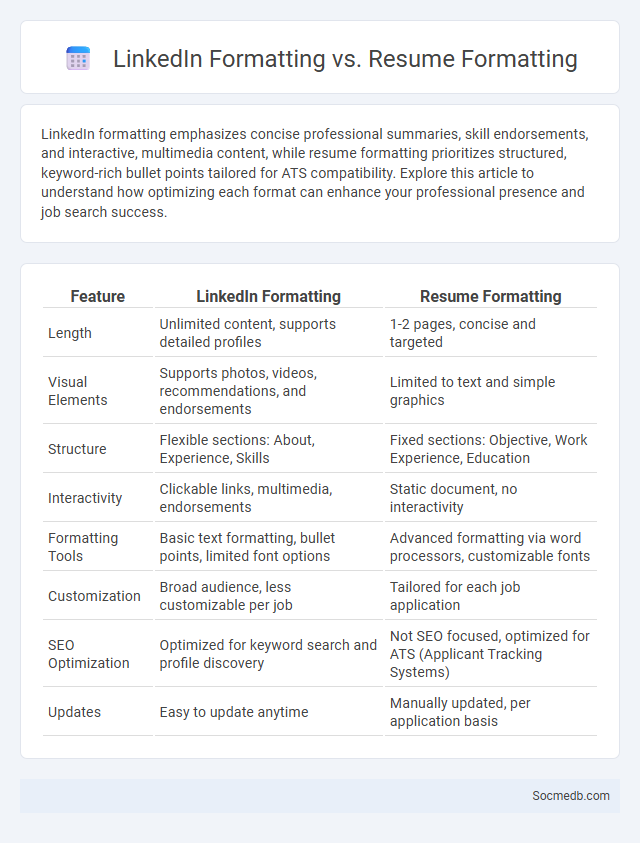
Photo illustration: LinkedIn Formatting vs Resume Formatting
LinkedIn formatting emphasizes concise professional summaries, skill endorsements, and interactive, multimedia content, while resume formatting prioritizes structured, keyword-rich bullet points tailored for ATS compatibility. Explore this article to understand how optimizing each format can enhance your professional presence and job search success.
Table of Comparison
| Feature | LinkedIn Formatting | Resume Formatting |
|---|---|---|
| Length | Unlimited content, supports detailed profiles | 1-2 pages, concise and targeted |
| Visual Elements | Supports photos, videos, recommendations, and endorsements | Limited to text and simple graphics |
| Structure | Flexible sections: About, Experience, Skills | Fixed sections: Objective, Work Experience, Education |
| Interactivity | Clickable links, multimedia, endorsements | Static document, no interactivity |
| Formatting Tools | Basic text formatting, bullet points, limited font options | Advanced formatting via word processors, customizable fonts |
| Customization | Broad audience, less customizable per job | Tailored for each job application |
| SEO Optimization | Optimized for keyword search and profile discovery | Not SEO focused, optimized for ATS (Applicant Tracking Systems) |
| Updates | Easy to update anytime | Manually updated, per application basis |
Understanding LinkedIn Profile Formatting
Understanding LinkedIn profile formatting involves structuring sections such as the headline, summary, experience, and skills to enhance visibility and professional appeal. Using relevant keywords tailored to your industry and role improves search engine optimization, increasing the chances of being discovered by recruiters and potential employers. Proper formatting with concise bullet points, consistent dates, and quantified achievements strengthens credibility and engagement on the platform.
Key Elements of Effective Resume Formatting
Effective resume formatting on social media platforms emphasizes clarity, concise information, and visual appeal to capture recruiters' attention quickly. Key elements include consistent font usage, strategic use of bullet points for easy readability, and inclusion of relevant keywords aligned with job descriptions to improve searchability. Incorporating hyperlinks to professional profiles or portfolios enhances credibility and allows for deeper engagement with potential employers.
Comparing LinkedIn and Resume Formatting Standards
LinkedIn profiles emphasize dynamic and keyword-rich content tailored for algorithm visibility and networking opportunities, whereas resume formatting standards prioritize concise, structured layouts optimized for human recruiters and applicant tracking systems (ATS). Your LinkedIn presence allows for multimedia integration and ongoing updates, while resumes demand strict adherence to format, font, and length guidelines to ensure readability and professionalism. Understanding these differences improves how you present your qualifications across platforms, maximizing your chances of career advancement.
Visual Layout: LinkedIn vs Resume
Visual layout plays a crucial role in presenting your professional identity on social media and resumes. LinkedIn profiles prioritize a clean, interactive design with sections for endorsements, multimedia, and dynamic updates, enhancing engagement and showcasing a comprehensive career narrative. Your resume should feature a streamlined, print-friendly format with clear headings, bullet points, and consistent fonts to highlight key achievements efficiently for quick recruiter scanning.
Content Depth: What to Highlight on Each Platform
Social media platforms demand tailored content depth to engage audiences effectively; Instagram thrives on visually rich posts that convey stories through images and infographics, while LinkedIn benefits from in-depth articles and professional insights that demonstrate industry expertise. Twitter requires concise, impactful messages designed for quick consumption and real-time interaction, focusing on trending topics and timely updates. Understanding your audience's platform-specific preferences helps you create content that resonates and drives meaningful engagement.
Professional Branding Across LinkedIn and Resumes
Building a consistent professional brand across LinkedIn and your resume enhances your visibility and credibility in your industry. Optimizing your LinkedIn profile with relevant keywords, detailed accomplishments, and endorsements aligns with the tailored content on your resume, making You stand out to recruiters and potential employers. Highlighting measurable achievements and maintaining a cohesive narrative between both platforms significantly boosts your chances of securing interviews.
Resume Optimization for ATS (Applicant Tracking Systems)
Optimizing your resume for Applicant Tracking Systems (ATS) requires incorporating relevant keywords from the job description and industry-specific terms to ensure visibility in social media recruitment platforms. Using clear, standard formatting and avoiding complex graphics helps ATS parse your information accurately, increasing the chances of your resume passing initial filters. Your strategic use of social media profiles linked within your resume can further enhance your digital footprint, making it easier for recruiters to validate your skills and experience.
Optimizing LinkedIn Profiles for Recruiter Searches
Optimizing LinkedIn profiles for recruiter searches involves incorporating industry-specific keywords and skills that align with target job descriptions. Enhancing headline, summary, and experience sections with quantifiable achievements boosts visibility in LinkedIn's search algorithm. Consistent updating of profile content and endorsements increases profile ranking, making candidates more discoverable to recruiters and hiring managers.
Common Formatting Mistakes to Avoid
Common formatting mistakes on social media include excessive use of hashtags without relevance, inconsistent capitalization that hampers readability, and neglecting to use line breaks or bullet points to organize content clearly. Ignoring platform-specific character limits and failing to optimize image sizes can also reduce engagement and visibility. Ensuring clean, well-structured posts boosts user interaction and strengthens brand presence.
Best Practices for Synchronizing LinkedIn and Resume
Synchronizing your LinkedIn profile with your resume ensures consistency that strengthens your professional brand and boosts credibility with recruiters. Highlight key achievements, skills, and job titles identically across both platforms to maximize keyword optimization and improve your visibility in applicant tracking systems. Regularly update and tailor your LinkedIn summary and resume to reflect your latest accomplishments, making it easier for Your network and potential employers to recognize your expertise and career progression.
 socmedb.com
socmedb.com